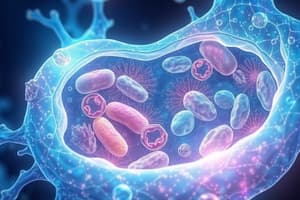Podcast
Questions and Answers
Which characteristic of living organisms refers to maintaining a stable internal environment?
Which characteristic of living organisms refers to maintaining a stable internal environment?
- Homeostasis (correct)
- Adaptation
- Metabolism
- Reproduction
What is the basic unit of life that composes all living organisms?
What is the basic unit of life that composes all living organisms?
- Organ
- Cell (correct)
- Molecule
- Tissue
Which level of biological organization comes immediately after organs?
Which level of biological organization comes immediately after organs?
- Organ systems (correct)
- Cells
- Tissues
- Populations
Which of the following is NOT a key area of biological study?
Which of the following is NOT a key area of biological study?
Which type of cell lacks a nucleus and membrane-bound organelles?
Which type of cell lacks a nucleus and membrane-bound organelles?
What process allows species to evolve in response to environmental changes?
What process allows species to evolve in response to environmental changes?
Which of these is the largest level of biological organization?
Which of these is the largest level of biological organization?
Which of the following best describes metabolism?
Which of the following best describes metabolism?
What is the correct sequence of the central dogma?
What is the correct sequence of the central dogma?
What does genetics primarily study?
What does genetics primarily study?
Which of the following is a key driver of evolution?
Which of the following is a key driver of evolution?
Which component is NOT typically included in ecological studies?
Which component is NOT typically included in ecological studies?
What is the first step in the scientific method?
What is the first step in the scientific method?
What does biodiversity encompass?
What does biodiversity encompass?
How are organisms classified in biology?
How are organisms classified in biology?
Which of the following statements about alleles is true?
Which of the following statements about alleles is true?
Flashcards
What is Biology?
What is Biology?
The scientific study of life and living organisms, encompassing their structure, function, growth, evolution, distribution, and taxonomy.
What is Metabolism?
What is Metabolism?
The ability of living organisms to acquire and use energy for growth, maintenance, and reproduction.
What is Adaptation?
What is Adaptation?
The process by which species evolve over time in response to environmental changes.
What is a Cell?
What is a Cell?
Signup and view all the flashcards
What are Prokaryotic Cells?
What are Prokaryotic Cells?
Signup and view all the flashcards
What are Eukaryotic Cells?
What are Eukaryotic Cells?
Signup and view all the flashcards
What is Homeostasis?
What is Homeostasis?
Signup and view all the flashcards
What is Reproduction?
What is Reproduction?
Signup and view all the flashcards
What is the central dogma of molecular biology?
What is the central dogma of molecular biology?
Signup and view all the flashcards
What does genetics study?
What does genetics study?
Signup and view all the flashcards
What is meant by biological evolution?
What is meant by biological evolution?
Signup and view all the flashcards
What is the study of ecology all about?
What is the study of ecology all about?
Signup and view all the flashcards
How do scientists approach studying the natural world?
How do scientists approach studying the natural world?
Signup and view all the flashcards
What is biodiversity, and why is it important?
What is biodiversity, and why is it important?
Signup and view all the flashcards
What is the system for classifying organisms?
What is the system for classifying organisms?
Signup and view all the flashcards
What are some of the threats to biodiversity?
What are some of the threats to biodiversity?
Signup and view all the flashcards
Study Notes
Introduction to Biology
- Biology is the scientific study of life and living organisms, encompassing their structure, function, growth, evolution, distribution, and taxonomy.
- Key areas of study include molecular biology, genetics, cell biology, developmental biology, ecology, evolutionary biology, and organismal biology.
- The study of biology relies heavily on the scientific method, using observation, hypothesis formation, experimentation, and data analysis to understand living systems.
Characteristics of Living Organisms
- Living organisms share several key characteristics, including:
- Organization: Composed of cells, the basic unit of life.
- Metabolism: Ability to acquire and use energy for growth, maintenance, and reproduction.
- Responsiveness: Ability to react to stimuli in the environment.
- Growth and Development: Increase in size and complexity over time.
- Reproduction: Ability to create new organisms, continuing the species.
- Adaptation: The process through which species evolve over time in response to environmental changes.
- Homeostasis: Ability to maintain a stable internal environment.
Levels of Biological Organization
- Biology studies life from the smallest to the largest scales, encompassing several levels of organization:
- Molecules: Smallest units of matter, forming the basis of biological structures.
- Cells: Basic unit of life, containing organelles and carrying out various functions.
- Tissues: Groups of similar cells working together.
- Organs: Groups of tissues working together.
- Organ systems: Groups of organs working together.
- Organisms: Individual living beings.
- Populations: Groups of the same species in the same area.
- Communities: Various interacting populations in a given area.
- Ecosystems: Interacting communities and their physical environment.
- Biosphere: All living organisms on Earth.
Cell Structure and Function
- Cells are the fundamental units of life, varying in structure and function depending on the organism's needs.
- Prokaryotic cells (bacteria and archaea) lack a nucleus and other membrane-bound organelles.
- Eukaryotic cells (plants, animals, fungi, protists) have a nucleus and other membrane-bound organelles, enabling compartmentalization of cellular functions.
The Central Dogma of Molecular Biology
- The central dogma describes the flow of genetic information within a biological system:
- DNA → RNA → Protein
- DNA carries the genetic code; RNA carries the code's instructions for protein synthesis; proteins perform cellular functions.
Genetics
- Genetics studies heredity, the transmission of traits from parents to offspring.
- Genes, which are segments of DNA, determine specific traits.
- Different alleles of a gene can lead to variations in traits.
Evolution
- Evolution is the change in heritable characteristics of biological populations over successive generations.
- Natural selection is a key driver of evolution, favoring traits that enhance survival and reproduction.
- Evolution is supported by substantial evidence from various fields, including fossil records, comparative anatomy, and molecular biology.
Ecology
- Ecology studies the interactions between organisms and their environment.
- Key ecological concepts include energy flow, nutrient cycles, population dynamics, and community structure.
- Ecosystems comprise interacting biotic (living) and abiotic (non-living) components.
Scientific Method
- The scientific method is a systematic approach to understanding the natural world:
- Observation: Recognizing a phenomenon.
- Hypothesis: Forming a testable explanation.
- Prediction: Forecasting outcomes based on the hypothesis.
- Experimentation: Testing the hypothesis.
- Analysis: Evaluating the results.
- Conclusion: Drawing inferences based on the data.
Biodiversity
- Biodiversity refers to the variety of life on Earth at all its levels, from genes to ecosystems.
- Biodiversity encompasses genetic diversity, species diversity, and ecosystem diversity.
- Loss of biodiversity is a current concern, driven by various factors like habitat destruction and climate change.
Classification of Organisms
- Organisms are classified based on shared characteristics into a hierarchical system (e.g., kingdom, phylum, class, order, family, genus, species).
- The system attempts to reflect evolutionary relationships among organisms.
Studying That Suits You
Use AI to generate personalized quizzes and flashcards to suit your learning preferences.




